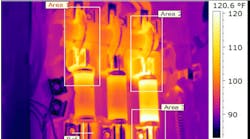A common reaction to an overloaded motor that repeatedly trips its protection unit (or burns open its “heaters”) is to “upgrade” the protection. This “solution” is arrived at after performing some cursory checks on the motor and not seeing any problems. “Must be the wrong size heaters; the motor seems fine.”
The motor might “seem” fine but not actually be fine. For example, it may have bearing problems (which are discoverable with ultrasonics).
But the motor itself might not be causing the overload condition. Causes may include a large change in load (e.g., a scrap grinder is fed too much at a time), misalignment, a broken drive gear, or improper motor drive settings. Power problems (e.g., low voltage or low power factor) also may cause an overload condition.
It’s easy enough to determine the correct size overloads. Once you’ve done that, you know that going larger may reduce the life of the motor.
Before you check the problems already mentioned, check the motor supply:
- Is the supply voltage correct? Chronically low voltage may result in those chronic overload trips.
- Are all phases present, or are you single-phasing?
- Are all phases at nearly the same voltage, or do you have voltage imbalance?
- What is the power factor at the motor?
- What does the power look like? Excess waveform distortion and harmonics may cause this problem.




